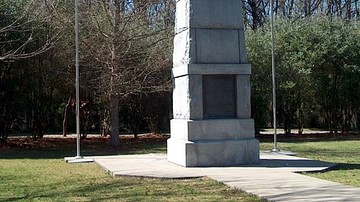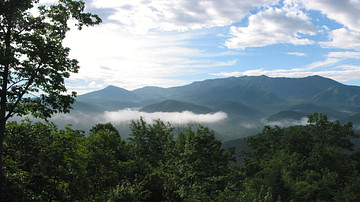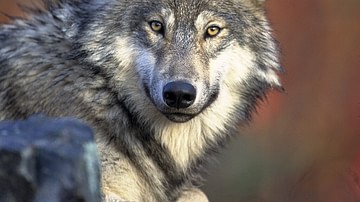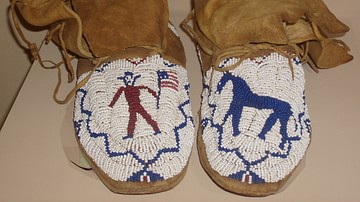The Daughter of the Sun is a Cherokee origin myth explaining how Uktena, the great horned serpent, came to be, as well as why those who die cannot return to life. The story also explains the respect due to the rattlesnake in Cherokee culture and references the location of the Darkening Land, the afterlife, which lay toward the west.
The creation of the Uktena serpent in this story is referenced in the Ulunsuti tales, notably The Uktena and the Ulunsuti, but The Daughter of the Sun is not considered one of these tales as it makes no mention of the jewel (the Ulunsuti) on the forehead of Uktena. At the same time, as it touches on the origin of Uktena, it could be considered an Ulunsuti tale. The story shares similarities with myths of other cultures including the Mesopotamian works Eridu Genesis and Atrahasis, the Egyptian Book of the Heavenly Cow, and the biblical tale of Noah's Ark, all of which feature a deity who becomes displeased with humans and decides to destroy them.
The Daughter of the Sun is also similar in theme to the Cherokee myth of Tsul'kălû', The Slant-Eyed Giant in its emphasis on the importance of following instructions (although this theme is fairly common in many stories from Native American Literature). In this story, however, there is some question as to whether the instructions were intended to be followed.
The Daughter of the Sun is among the most popular Cherokee myths and legends and is still recited by storytellers in Cherokee communities today, not only for its entertainment value but also because it preserves traditional Cherokee values and concepts including balance, harmony, the spiritual life of the natural world, and the Little People who appear in the legends and lore of many Native peoples of North America.
Spirituality, Balance, & the Little People
The Cherokee, as with Native American nations generally, hold balance as a central cultural value. Life should be lived in harmony with oneself, one's community, the natural world, and the unseen world of spirits and the divine. In Cherokee belief, the Creator, Unetlanvhi, made the earthly realm as a middle plane between the upper world of bright spirits, who encourage health, balance, and happiness, and the lower world of the dark spirits, who bring sickness, disorder, despair, and death. Humans are supposed to maintain the balance between these worlds, recognizing the dark forces for what they are and honoring the benevolent energies for their gifts and guidance.
According to Cherokee lore, the Little People (Yûñwĭ Tsunsdi′) are a race of mystical beings, neither dark nor light spirits, who help maintain the celestial balance. At one point, they might play tricks on people or punish them for some perceived or actual transgression, and at another, they provide help, guidance, and inspiration. The Little People of the Cherokee are also known to be especially fond of children, caring for those who become separated from their parents, whether through the parents' death or becoming lost or abducted, and taking others from abusive homes. The Little People could be appealed to for help, as in this story, where the Cherokee ask them for assistance in stopping the sun from killing them.
The Little People (referred to as "Little Men" in the story) lend them help by way of transforming some of the men into venomous snakes – the adder, copperhead, rattlesnake, and the great horned serpent, Uktena. The idea is to have the serpents kill the sun and stop its rampage but, in execution, things do not go as planned. The people themselves are forced to deal with their problems with the sun, and do so successfully, suggesting that, perhaps, they did not need the aid of the Little People to begin with.
The Little People are not the same as the Nûñnĕ′hĭ and other spirit folk, who are supernatural entities that can sometimes appear as people and, at other times, in different forms. The Little People always appear in more or less the same way as humans, just as the leprechaun of Ireland or the pixie of Britain are said to do, but the Little People and the Nûñnĕ′hĭ have one central characteristic in common: they are or can be tricksters. Scholar Larry J. Zimmerman writes:
Unlike heroes, tricksters deceive others in pursuit of self-gratification: they tend to be mischievous, selfish, and rascally, and usually have exaggerated human characteristics…A trickster commonly appears as a semi-divine but largely amoral presence at the creation, and he may permanently transform such things as an animal's appearance or the course of a river.
(186)
The Little People of the Cherokee are not tricksters in the same sense as Wihio of the Wihio tales of the Cheyenne or Iktomi of the Iktomi tales of the Sioux – where 'trickster' is essentially their fixed persona – but can, at times, take on that role when it suits them. At the same time, it would seem that what 'suits them' also serves a greater purpose.
As the Little People are famous for playing tricks, the 'help' they offer in The Daughter of the Sun may not actually have been intended to help at all. It is possible that, in creating the venomous serpents, the Little People were encouraging the Cherokee to find a way to help themselves and, in doing so, perform the task assigned to them by the Creator: to keep balance. Unlike similar apocalyptic tales from Mesopotamia, Egypt, and the Bible, the threat to humanity is not finally addressed by the deity but by the people themselves.
The primary focus of the story is on the Sun's rage over people's reaction to her and their response to her attempt at wiping them out. As the story begins, life is out of balance and the help offered by the Little People – the assassination of the Sun and the return of the Daughter of the Sun from the land of the dead – actually threatens balance further, even though the people accept their help in the belief it will restore order. One interpretation of the tale could be that the Little People already know what will happen once their suggestions are implemented, and the failure of their plans is actually what succeeds in restoring and maintaining balance.
Text
The following text comes from Myths of the Cherokee (1900) by James Mooney, republished in 2014 by Dover Publications.
The Sun lived on the other side of the sky vault, but her daughter lived in the middle of the sky, directly above the earth, and every day as the Sun was climbing along the sky arch to the west she used to stop at her daughter's house for dinner.
Now, the Sun hated the people on the earth because they could never look straight at her without screwing up their faces. She said to her brother, the Moon, "My grandchildren are ugly; they grin all over their faces when they look at me." But the Moon said, "I like my younger brothers; I think they are very handsome"—because they always smiled pleasantly when they saw him in the sky at night, for his rays were milder.
The Sun was jealous and planned to kill all the people, so every day when she got near her daughter's house, she sent down such sultry rays that there was a great fever and the people died by hundreds, until everyone had lost some friend and there was fear that no one would be left. They went for help to the Little Men, who said the only way to save themselves was to kill the Sun.
The Little Men made medicine and changed two men to snakes, the Spreading-adder and the Copperhead, and sent them to watch near the door of the daughter of the Sun to bite the old Sun when she came next day. They went together and hid near the house until the Sun came, but when the Spreading-adder was about to spring, the bright light blinded him and he could only spit out yellow slime, as he does to this day when he tries to bite. She called him a nasty thing and went by into the house, and the Copperhead crawled off without trying to do anything.
So, the people still died from the heat, and they went to the Little Men a second time for help. The Little Men made medicine again and changed one man into the great Uktena and another into the Rattlesnake and sent them to watch near the house and kill the old Sun when she came for dinner. They made the Uktena very large, with horns on his head, and everyone thought he would be sure to do the work, but the Rattlesnake was so quick and eager that he got ahead and coiled up just outside the house, and when the Sun's daughter opened the door to look out for her mother, he sprang up and bit her and she fell dead in the doorway.
He forgot to wait for the old Sun, but went back to the people, and the Uktena was so very angry that he went back, too. Since then, we pray to the rattlesnake and do not kill him, because he is kind and never tries to bite if we do not disturb him. The Uktena grew angrier all the time and very dangerous, so that if he even looked at a man, that man's family would die. After a long time, the people held a council and decided that he was too dangerous to be with them, so they sent him up to Gălûñ′lătĭ, and he is there now. The Spreading-adder, the Copperhead, the Rattlesnake, and the Uktena were all men.
When the Sun found her daughter dead, she went into the house and grieved, and the people did not die any more, but now the world was dark all the time, because the Sun would not come out. They went again to the Little Men, and these told them that if they wanted the Sun to come out again, they must bring back her daughter from Tsûsginâ′ĭ, the Ghost country, in Usûñhi′yĭ, the Darkening land in the west. They chose seven men to go and gave each a sourwood rod a handbreadth long. The Little Men told them they must take a box with them, and when they got to Tsûsginâ′ĭ they would find all the ghosts at a dance. They must stand outside the circle, and when the young woman passed in the dance, they must strike her with the rods, and she would fall to the ground. Then they must put her into the box and bring her back to her mother, but they must be very sure not to open the box, even a little way, until they were home again.
They took the rods and a box and traveled seven days to the west until they came to the Darkening Land. There were a great many people there, and they were having a dance just as if they were at home in the settlements. The young woman was in the outside circle, and as she swung around to where the seven men were standing, one struck her with his rod, and she turned her head and saw him. As she came around the second time another touched her with his rod, and then another and another, until at the seventh round she fell out of the ring, and they put her into the box and closed the lid fast. The other ghosts seemed never to notice what had happened.
They took up the box and started home toward the east. In a little while the girl came to life again and begged to be let out of the box, but they made no answer and went on. Soon she called again and said she was hungry, but still they made no answer and went on. After another while she spoke again and called for a drink and pleaded so that it was very hard to listen to her, but the men who carried the box said nothing and still went on. When at last they were very near home, she called again and begged them to raise the lid just a little, because she was smothering. They were afraid she was really dying now, so they lifted the lid a little to give her air, but as they did so there was a fluttering sound inside and something flew past them into the thicket and they heard a redbird cry, "kwish! kwish! kwish!" in the bushes. They shut down the lid and went on again to the settlements, but when they got there and opened the box it was empty.
So, we know the Redbird is the daughter of the Sun, and if the men had kept the box closed, as the Little Men told them to do, they would have brought her home safely, and we could bring back our other friends also from the Ghost country, but now when they die, we can never bring them back.
The Sun had been glad when they started to the Ghost country, but when they came back without her daughter she grieved and cried, "My daughter, my daughter," and wept until her tears made a flood upon the earth, and the people were afraid the world would be drowned. They held another council and sent their handsomest young men and women to amuse her so that she would stop crying. They danced before the Sun and sang their best songs, but for a long time she kept her face covered and paid no attention, until at last the drummer suddenly changed the song, when she lifted up her face, and was so pleased at the sight that she forgot her grief and smiled.






